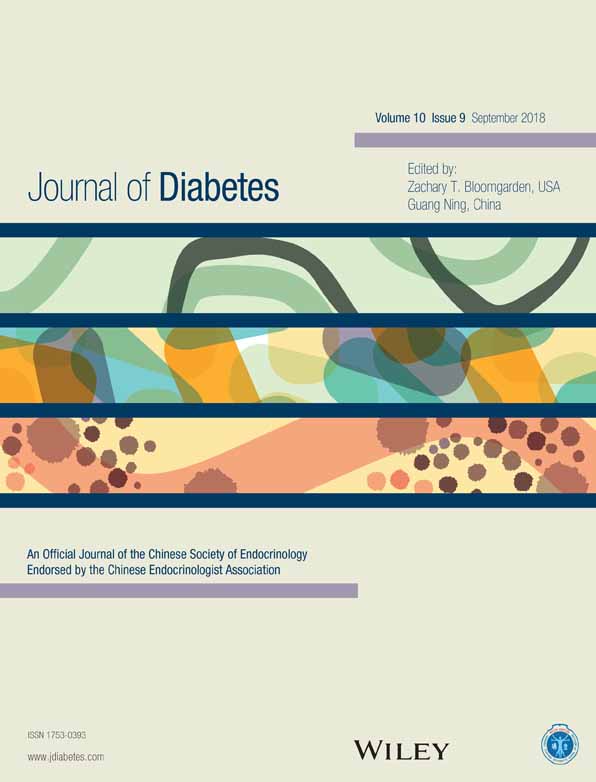Non-high-density lipoprotein cholesterol: High-density lipoprotein cholesterol ratio is an independent risk factor for diabetes mellitus: Results from a population-based cohort study
非高密度脂蛋白胆固醇与高密度脂蛋白胆固醇的比值是糖尿病的独立危险因素:来自一项基于人群的队列研究的结论
Abstract
enBackground
Dyslipidemia predicts the development and progression of diabetes. A higher non-high-density lipoprotein cholesterol (HDL-C): HDL-C ratio is reportedly associated with metabolic syndrome and insulin resistance, but its relationship with glycemic levels and diabetes remains unclear.
Methods
In all, 4882 subjects aged ≥40 years without diabetes and not using lipid-lowering drugs were enrolled in the study. The non-HDL-C: HDL-C ratio was log10 transformed to achieve normal distribution. Multivariate logistic regression was used to investigate the association between the log10-transformed non-HDL-C: HDL-C ratio and diabetes. Stratified analyses of the association by age, gender, and body mass index (BMI) were also performed.
Results
After 3 years of follow-up, 704 participants developed diabetes. After adjustment for age, gender, current smoking, current drinking, physical activity, BMI, systolic blood pressure, and family history of diabetes, each 1-SD increase in the log(non-HDL-C: HDL-C ratio) was associated with higher fasting blood glucose (FPG) levels (β = 0.1; 95% confidence interval [CI] 0.1–0.1), 2-h postload plasma glucose levels (2-h glucose; β = 0.2; 95% CI 0.1–0.2), and risk of diabetes (odds ratio [OR] 1.1; 95% CI 1.0–1.2). In a multivariate model, subjects in the top quartile of non-HDL-C: HDL-C ratio had higher FPG (β = 0.2; 95% CI 0.2–0.3), 2-h glucose (β = 0.5; 95% CI 0.3–0.7) and HbA1c (β = 0.1; 95% CI 0.1–0.2) levels, and a 40% increased risk of diabetes (OR 1.4; 95% CI 1.1–1.8) than participants in the bottom quartile.
Conclusions
The non-HDL-C: HDL-C ratio was found to be an independent risk factor for diabetes.
摘要
zh背景
血脂紊乱与糖尿病的发生发展密切相关。研究表明非高密度脂蛋白胆固醇(non-high-density lipoprotein cholesterol, non-HDL-C)与高密度脂蛋白胆固醇(high-density lipoprotein cholesterol, HDL-C)的比值(non-HDL-C/HDL-C)的升高与代谢综合征以及胰岛素抵抗的发生相关, 然而non-HDL-C/HDL-C与血糖水平以及糖尿病的发病风险之间的关系目前仍不清楚。
方法
本研究中, 我们纳入了4882名年龄不小于40周岁, 基线无糖尿病且基线未用降脂药的参与者。因non-HDL-C/HDL-C呈偏态分布, 对所有参与者的non-HDL-C/HDL-C水平均进行了对数转换。用多元逻辑回归分析(Multivariate logistic regression)评价对数转换后的non-HDL-C/HDL-C水平(log10-transformed non-HDL-C/HDL-C)与糖尿病的关系。并进一步进行了年龄、性别及体质指数等的亚组分析。
结果
经过3年的随访后, 共有704名研究对象发生了糖尿病。在调整了年龄、性别、吸烟、饮酒、体力活动、体质指数、收缩压以及糖尿病家族史等混杂因素之后, 对数转换后的 non-HDL-C/HDL-C水平的升高与空腹血糖(β= 0.1;95%置信区间 [CI] 0.1-0.1)、糖负荷后2小时血糖(β= 0.2;95% CI 0.1-0.2)以及糖尿病发病风险(比值比[OR] 1.1;95% CI 1.0-1.2)的升高均有显著相关性。并且在多变量模型中, non-HDL-C/HDL-C水平最高的25%的人群与non-HDL-C/HDL-C水平最低的25%的人群相比, 空腹血糖(β= 0.2;95% CI 0.2-0.3), 糖负荷后2小时血糖(β= 0.5;95% CI 0.3-0.7), 糖化血红蛋白(β= 0.1;95% CI 0.1-0.2)均显著升高, 糖尿病发病风险升高达40%(OR 1.4;95% CI 1.1-1.8)。
结论
non-HDL-C/HDL-C水平是糖尿病发病的独立危险因素。




